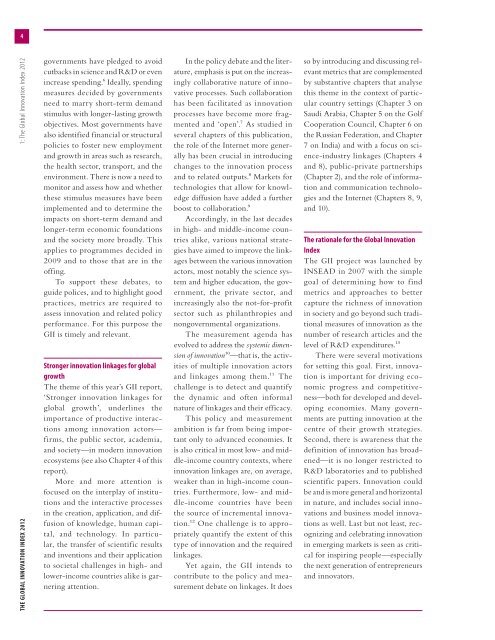The Global Innovation Index 2012
The Global Innovation Index 2012
The Global Innovation Index 2012
You also want an ePaper? Increase the reach of your titles
YUMPU automatically turns print PDFs into web optimized ePapers that Google loves.
4<br />
THE GLOBAL INNOVATION INDEX <strong>2012</strong> 1: <strong>The</strong> <strong>Global</strong> <strong>Innovation</strong> <strong>Index</strong> <strong>2012</strong><br />
governments have pledged to avoid<br />
cutbacks in science and R&D or even<br />
increase spending.6 Ideally, spending<br />
measures decided by governments<br />
need to marry short-term demand<br />
stimulus with longer-lasting growth<br />
objectives. Most governments have<br />
also identified financial or structural<br />
policies to foster new employment<br />
and growth in areas such as research,<br />
the health sector, transport, and the<br />
environment. <strong>The</strong>re is now a need to<br />
monitor and assess how and whether<br />
these stimulus measures have been<br />
implemented and to determine the<br />
impacts on short-term demand and<br />
longer-term economic foundations<br />
and the society more broadly. This<br />
applies to programmes decided in<br />
2009 and to those that are in the<br />
offing.<br />
To support these debates, to<br />
guide polices, and to highlight good<br />
practices, metrics are required to<br />
assess innovation and related policy<br />
performance. For this purpose the<br />
GII is timely and relevant.<br />
Stronger innovation linkages for global<br />
growth<br />
<strong>The</strong> theme of this year’s GII report,<br />
‘Stronger innovation linkages for<br />
global growth’, underlines the<br />
importance of productive interactions<br />
among innovation actors—<br />
firms, the public sector, academia,<br />
and society—in modern innovation<br />
ecosystems (see also Chapter 4 of this<br />
report).<br />
More and more attention is<br />
focused on the interplay of institutions<br />
and the interactive processes<br />
in the creation, application, and diffusion<br />
of knowledge, human capital,<br />
and technology. In particular,<br />
the transfer of scientific results<br />
and inventions and their application<br />
to societal challenges in high- and<br />
lower-income countries alike is garnering<br />
attention.<br />
In the policy debate and the literature,<br />
emphasis is put on the increasingly<br />
collaborative nature of innovative<br />
processes. Such collaboration<br />
has been facilitated as innovation<br />
processes have become more fragmented<br />
and ‘open’.7 As studied in<br />
several chapters of this publication,<br />
the role of the Internet more generally<br />
has been crucial in introducing<br />
changes to the innovation process<br />
and to related outputs.8 Markets for<br />
technologies that allow for knowledge<br />
diffusion have added a further<br />
boost to collaboration.9<br />
Accordingly, in the last decades<br />
in high- and middle-income countries<br />
alike, various national strategies<br />
have aimed to improve the linkages<br />
between the various innovation<br />
actors, most notably the science system<br />
and higher education, the government,<br />
the private sector, and<br />
increasingly also the not-for-profit<br />
sector such as philanthropies and<br />
nongovernmental organizations.<br />
<strong>The</strong> measurement agenda has<br />
evolved to address the systemic dimension<br />
of innovation10—that is, the activities<br />
of multiple innovation actors<br />
and linkages among them.11 <strong>The</strong><br />
challenge is to detect and quantify<br />
the dynamic and often informal<br />
nature of linkages and their efficacy.<br />
This policy and measurement<br />
ambition is far from being important<br />
only to advanced economies. It<br />
is also critical in most low- and middle-income<br />
country contexts, where<br />
innovation linkages are, on average,<br />
weaker than in high-income countries.<br />
Furthermore, low- and middle-income<br />
countries have been<br />
the source of incremental innovation.12<br />
One challenge is to appropriately<br />
quantify the extent of this<br />
type of innovation and the required<br />
linkages.<br />
Yet again, the GII intends to<br />
contribute to the policy and measurement<br />
debate on linkages. It does<br />
so by introducing and discussing relevant<br />
metrics that are complemented<br />
by substantive chapters that analyse<br />
this theme in the context of particular<br />
country settings (Chapter 3 on<br />
Saudi Arabia, Chapter 5 on the Golf<br />
Cooperation Council, Chapter 6 on<br />
the Russian Federation, and Chapter<br />
7 on India) and with a focus on science-industry<br />
linkages (Chapters 4<br />
and 8), public-private partnerships<br />
(Chapter 2), and the role of information<br />
and communication technologies<br />
and the Internet (Chapters 8, 9,<br />
and 10).<br />
<strong>The</strong> rationale for the <strong>Global</strong> <strong>Innovation</strong><br />
<strong>Index</strong><br />
<strong>The</strong> GII project was launched by<br />
INSEAD in 2007 with the simple<br />
goal of determining how to find<br />
metrics and approaches to better<br />
capture the richness of innovation<br />
in society and go beyond such traditional<br />
measures of innovation as the<br />
number of research articles and the<br />
level of R&D expenditures.13<br />
<strong>The</strong>re were several motivations<br />
for setting this goal. First, innovation<br />
is important for driving economic<br />
progress and competitiveness—both<br />
for developed and developing<br />
economies. Many governments<br />
are putting innovation at the<br />
centre of their growth strategies.<br />
Second, there is awareness that the<br />
definition of innovation has broadened—it<br />
is no longer restricted to<br />
R&D laboratories and to published<br />
scientific papers. <strong>Innovation</strong> could<br />
be and is more general and horizontal<br />
in nature, and includes social innovations<br />
and business model innovations<br />
as well. Last but not least, recognizing<br />
and celebrating innovation<br />
in emerging markets is seen as critical<br />
for inspiring people—especially<br />
the next generation of entrepreneurs<br />
and innovators.






